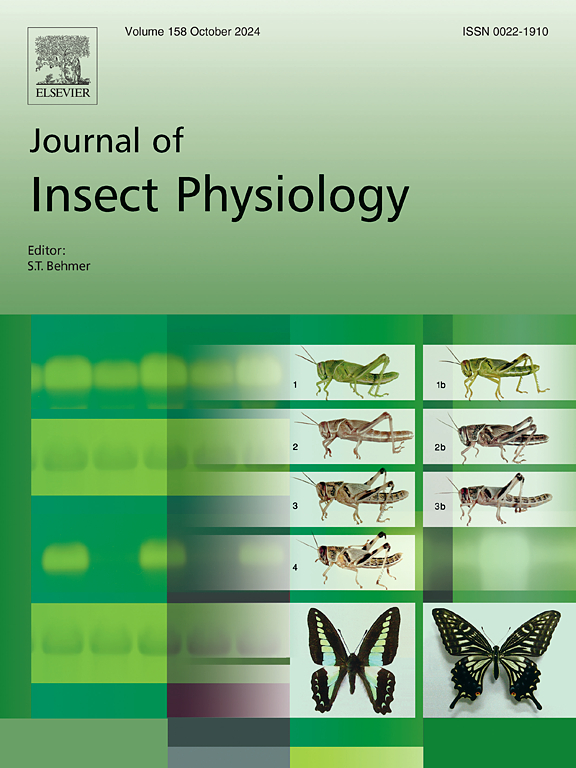Differential regulation of reproduction and molting by juvenile hormone in aphids
IF 2.3
2区 农林科学
Q1 ENTOMOLOGY
引用次数: 0
Abstract
Insects rely on juvenile hormones to regulate various physiological processes, including reproduction and molting; currently eight forms of this hormone are known. In most insects, only JH Ⅲ is synthesized. Meanwhile, aphids produce JH Ⅲ and JH Ⅲ skipped bisepoxide (JHSB3). However, it remains unclear whether these compounds play distinct roles in functional regulation. In this study, we demonstrated that the tested concentrations of JH Ⅲ effectively increased the number of aphid offspring, whereas high concentrations of JHSB3 affected the molting process. Drip experiments showed that 10 mg/L JH Ⅲ increased the number of offspring from 39.38 ± 8.03 to 56.50 ± 13.17, whereas 10 mg/L JHSB3 resulted in a 60.00 %± 5.77 % failure rate in molting before adulthood. Transcriptomic analysis also revealed that in the JH Ⅲ treatment group, 9 genes and 7 pathways associated with reproduction were expressed, but not genes or pathways associated with molting. In addition, 16 genes and 9 pathways associated with molting as well as 5 genes and 4 pathways associated with reproduction were identified in the JHSB3 treatment group. JH Ⅲ promotes reproduction in aphids by enhancing Vg expression, whereas JHSB3 affects molting by inhibiting the synthesis of molting hormone–related enzymes. The results indicate that JH Ⅲ and JHSB3 exhibit diverse functions in Aphis craccivora. The findings have significant implications for further studies on the physiological functions of different JHs.

幼体激素对蚜虫繁殖和换壳的差异调控。
昆虫依靠幼体激素来调节各种生理过程,包括繁殖和蜕皮;目前已知这种激素有八种形式。在大多数昆虫中,只有JHⅢ被合成。同时,蚜虫产生JHⅢ和JHⅢ跳过的二环氧化物(JHSB3)。然而,尚不清楚这些化合物是否在功能调节中发挥不同的作用。在本研究中,我们证明了JHⅢ的测试浓度有效地增加了蚜虫的后代数量,而高浓度的JHSB3影响了蚜虫的蜕皮过程。滴实验表明,10 mg / L JHⅢ 增加后代的数量从39.38 ± 8.03到56.50 ±13.17 ,而10 mg / L JHSB3 导致 % 60.00±5.77 %失败率在蜕皮成年。转录组学分析还发现,在JHⅢ处理组中,表达了9个与繁殖相关的基因和7条途径,但没有表达与蜕皮相关的基因或途径。此外,在JHSB3处理组中,鉴定出与蜕皮相关的16个基因和9条通路以及与繁殖相关的5个基因和4条通路。JHⅢ通过提高Vg的表达促进蚜虫的繁殖,而JHSB3通过抑制蜕皮激素相关酶的合成来影响蜕皮。结果表明,JHⅢ和JHSB3在蚜虫中表现出不同的功能。这一发现对进一步研究不同JHs的生理功能具有重要意义。
本文章由计算机程序翻译,如有差异,请以英文原文为准。
求助全文
约1分钟内获得全文
求助全文
来源期刊

Journal of insect physiology
生物-昆虫学
CiteScore
4.50
自引率
4.50%
发文量
77
审稿时长
57 days
期刊介绍:
All aspects of insect physiology are published in this journal which will also accept papers on the physiology of other arthropods, if the referees consider the work to be of general interest. The coverage includes endocrinology (in relation to moulting, reproduction and metabolism), pheromones, neurobiology (cellular, integrative and developmental), physiological pharmacology, nutrition (food selection, digestion and absorption), homeostasis, excretion, reproduction and behaviour. Papers covering functional genomics and molecular approaches to physiological problems will also be included. Communications on structure and applied entomology can be published if the subject matter has an explicit bearing on the physiology of arthropods. Review articles and novel method papers are also welcomed.
 求助内容:
求助内容: 应助结果提醒方式:
应助结果提醒方式:


